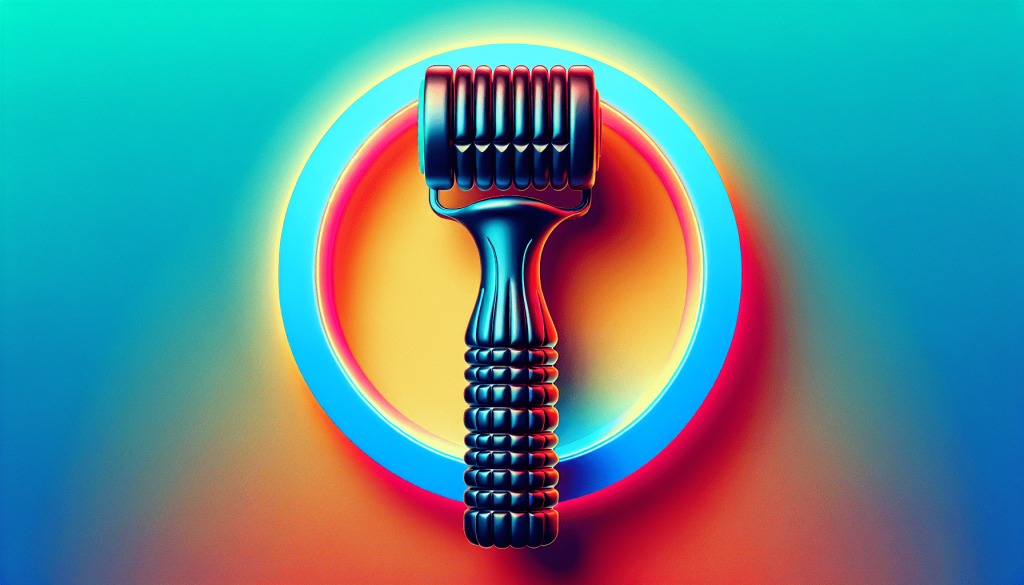
If you are new to the world of fitness and are looking for a tool that can aid in your recovery and maximize your workout results, then vibrating foam rollers might be just what you need. These innovative devices are not your typical foam rollers – they have an added vibration feature that provides a deeper and more targeted massage. In this article, we will explore the benefits of vibrating foam rollers and provide you with some tips to help you get started on your foam rolling journey. So, get ready to roll your way to a better, more rejuvenated body.

This image is property of images.pexels.com.
Table of Contents
Choosing the Right Vibrating Foam Roller
Consider the intensity levels
When choosing a vibrating foam roller, one of the first things to consider is the intensity levels it offers. Different foam rollers have different vibration settings, ranging from low to high intensity. It’s important to choose one that matches your fitness level and needs. If you’re just starting out or have sensitive muscles, a lower intensity setting may be more suitable. On the other hand, if you’re experienced with foam rolling and prefer a more intense massage, you can opt for a roller with higher intensity levels.
Look for a durable construction
Durability is another crucial factor to consider when selecting a vibrating foam roller. You want to invest in a roller that will withstand frequent use and maintain its effectiveness over time. Look for foam rollers made from high-quality materials, such as dense foam, sturdy plastic, or even metal. A roller with a strong construction will provide better support and prevent any potential damage or wear and tear.
Check the size and shape
The size and shape of the vibrating foam roller can greatly impact your experience. Consider the areas of your body you primarily want to target and choose a roller that accommodates those needs. For larger muscle groups, a longer and wider roller may be more suitable, while a smaller roller can be more effective for targeting specific, hard-to-reach areas. Additionally, the shape of the roller can vary, with some having ridges or grooves designed to enhance the massage. Experiment with different sizes and shapes to find what works best for you.
Consider the noise level
Noise level is an important factor to consider, especially if you plan on using your vibrating foam roller in shared spaces or quiet environments. Some foam rollers can produce loud vibrating sounds that may be bothersome to yourself or those around you. Look for rollers that have noise-reducing features or quieter motors to minimize any potential disruptions. It’s also a good idea to read user reviews and testimonials to get an idea of how noisy a particular foam roller may be.
Choose a portable option
If you plan on using your vibrating foam roller on the go or taking it with you to the gym, portability is key. Consider the weight and size of the roller to ensure it’s convenient to carry around. Some foam rollers come with a compact and lightweight design, making them easy to pack in a bag or backpack. Additionally, look for rollers that come with a travel case or carrying strap for added convenience. Choosing a portable option will allow you to incorporate foam rolling into your fitness routine wherever and whenever you need it.
Understanding How Vibrating Foam Rollers Work
Explaining the vibrations
Vibrating foam rollers work by using a motor or a vibration mechanism embedded within the roller to provide oscillating vibrations. These vibrations create a pulsating effect that penetrates deep into the muscles, providing a massage-like sensation. The intensity of the vibrations can be adjusted to suit your preferences and needs. The vibrations target the muscle tissue and fascia, helping to release tension, improve blood flow, and promote faster muscle recovery.
Benefits of using vibrating foam rollers
Using a vibrating foam roller offers numerous benefits for both beginners and experienced fitness enthusiasts. The vibrations help to relax tight muscles, alleviate soreness, and reduce muscle tension. The pulsations also stimulate blood circulation, which can enhance the delivery of oxygen and essential nutrients to the muscles, aiding in their recovery. Vibrating foam rollers can also improve flexibility and range of motion, allowing for better performance during workouts and reducing the risk of injuries.
Understanding the different vibration settings
Most vibrating foam rollers come with multiple vibration settings to cater to different needs. These settings allow you to adjust the intensity of the vibrations according to your comfort level and muscle soreness. Lower intensity settings are ideal for beginners or those with sensitive muscles, while higher intensity settings are suitable for individuals who prefer a deeper massage or have more resilient muscles. It’s important to start with a lower intensity setting and gradually increase it as your muscles adapt and become accustomed to the vibrations.
Preparing for a Vibrating Foam Rolling Session
Warm up your muscles
Before starting a vibrating foam rolling session, it’s essential to warm up your muscles to prevent injuries and maximize the benefits. Perform a few minutes of light cardio exercises, such as jogging or jumping jacks, to get your blood flowing and increase muscle temperature. This will make your muscles more pliable and receptive to the foam rolling techniques.
Choose a suitable exercise mat
To ensure a comfortable and effective foam rolling session, choose a suitable exercise mat or a padded surface. This will provide cushioning and support for your body as you roll, preventing any discomfort or unnecessary pressure on your joints. Look for an exercise mat with adequate thickness and grip to create a stable and safe environment for your foam rolling routine.
Start with low vibration intensity
If you’re new to vibrating foam rolling or have sensitive muscles, it’s recommended to start with a low vibration intensity setting. This will allow your muscles to gradually adapt to the vibrations and minimize any discomfort or soreness. As you become more comfortable and your muscles acclimate to the vibrations, you can gradually increase the intensity to experience a deeper massage and enhanced benefits.
Learn proper foam rolling techniques
Proper technique is crucial when using a vibrating foam roller to ensure effective and safe muscle release. Familiarize yourself with the correct foam rolling techniques for different muscle groups. Roll slowly and evenly, applying gentle pressure to the targeted areas. It’s important to avoid rolling directly over bones or joints and focus on the soft tissue surrounding the muscles. You can find instructional videos or seek guidance from a fitness professional to learn the proper techniques for different muscle groups.
Focus on targeted muscle groups
One of the advantages of vibrating foam rollers is the ability to target specific muscle groups. Depending on your fitness goals or areas of tightness, focus on rolling the specific muscles that require attention. This could be the calves, quadriceps, hamstrings, glutes, or any other area that feels tight or sore. Spend more time rolling these areas to release tension and improve flexibility. It’s important to listen to your body and adjust the amount of pressure applied to each muscle group accordingly.
Using a Vibrating Foam Roller Safely
Avoid sensitive areas and injuries
When using a vibrating foam roller, it’s important to avoid sensitive areas or any injuries. Do not roll directly over joints, bones, or areas that are inflamed, irritated, or recovering from an injury. Vibrating foam rolling should be used as a tool for muscle recovery and not as a treatment for acute injuries or medical conditions. If you have any concerns or existing injuries, consult a healthcare professional before incorporating vibrating foam rolling into your routine.
Do not exceed recommended usage time
While vibrating foam rolling can be beneficial, it’s important not to overdo it. Do not exceed the recommended usage time for your foam roller. Most manufacturers provide guidance on the optimal duration for each rolling session. Excessive or prolonged foam rolling can cause discomfort, muscle soreness, or even injury. Stick to the recommended usage time and gradually increase it as your body adjusts to the vibrations.
Take breaks if needed
If you experience any discomfort or feel fatigued during a foam rolling session, listen to your body and take breaks as needed. It’s normal to feel some level of discomfort, especially when first starting out or targeting tight muscles. However, if the discomfort becomes too intense or persists, it’s a sign to take a break and allow your muscles to recover. Remember to breathe deeply and relax while foam rolling to enhance the benefits and reduce muscle tension.
Listen to your body’s response
Every individual’s body is different, so it’s important to pay attention to how your body responds to vibrating foam rolling. If you experience any unusual pain, acute discomfort, or worsening of symptoms during or after a foam rolling session, it’s important to stop and assess the situation. Vibrating foam rolling should not cause severe pain or exacerbate existing injuries. If you have any concerns or uncertainties, consult a healthcare professional to ensure you’re using the foam roller safely and effectively.
Consult a healthcare professional if necessary
If you have any pre-existing medical conditions, injuries, or chronic pain, it’s important to consult a healthcare professional before incorporating vibrating foam rolling into your fitness routine. They can provide personalized guidance, assess the compatibility of foam rolling with your condition, and recommend specific techniques or modifications to ensure safety and optimal results.

This image is property of images.pexels.com.
Incorporating Vibrating Foam Rolling into Your Fitness Routine
Use before and after workouts
Vibrating foam rolling can be used both before and after workouts to enhance performance and aid in recovery. Before a workout, foam rolling can help to warm up your muscles, increase blood flow, and prepare your body for exercise. It can also improve your range of motion and flexibility, allowing for better movement during your workout. After a workout, foam rolling can help release muscle tightness, reduce post-exercise soreness, and promote faster recovery.
Include it in your warm-up routine
adding vibrating foam rolling to your warm-up routine can be highly beneficial. Before starting your regular warm-up exercises, spend a few minutes foam rolling the major muscle groups you’ll be working. This will help to increase circulation, loosen up the muscles, and enhance their readiness for the upcoming activity. Incorporating foam rolling into your warm-up routine can also improve muscle activation and overall performance during your workout.
Recovery and relaxation after intense workouts
After an intense workout, your muscles may be tight, sore, or fatigued. Vibrating foam rolling can be a valuable tool for post-workout recovery and relaxation. Spend some time foam rolling the muscles you worked during your exercise routine, focusing on any areas of tension or soreness. The vibrations will help to relax the muscles, reduce post-workout soreness, and prevent muscle stiffness. It’s a soothing and effective way to promote muscle recovery and overall relaxation.
Enhancing flexibility and mobility
Flexibility and mobility are key components of overall fitness and can greatly impact your performance and well-being. Incorporating vibrating foam rolling into your fitness routine can help improve flexibility and increase range of motion. By releasing tight muscles, breaking up adhesions, and enhancing blood flow, foam rolling helps to increase joint mobility and muscle elasticity. Regular foam rolling can lead to improved flexibility, allowing for better movement during workouts and reducing the risk of injuries.
Target specific muscle soreness or tightness
One of the advantages of vibrating foam rollers is their ability to target specific muscle soreness or tightness. If you have a particular area of your body that feels especially tight or sore, you can use the foam roller to focus on that area. Spend extra time rolling the targeted muscles to release tension and promote relaxation. Vibrating foam rolling allows you to precisely target trouble spots, providing a more effective massage and aiding in muscle recovery.
Cleaning and Maintaining Your Vibrating Foam Roller
Regularly wipe down the surface
To keep your vibrating foam roller clean and free from dirt or sweat, it’s important to regularly wipe down the surface. Use a clean cloth or disinfectant wipes to remove any debris or bacteria from the roller. This will help maintain a hygienic surface for your foam rolling sessions and prevent the buildup of odors or stains.
Use mild soap and water for deeper cleaning
For deeper cleaning, you can use mild soap and water to cleanse your vibrating foam roller. Fill a basin or sink with warm water and add a small amount of mild soap. Gently submerge the roller and use a soft cloth or sponge to clean the surface. Afterwards, rinse the roller thoroughly with clean water to remove any soap residue. Allow it to air dry completely before using or storing.
Dry thoroughly before storing
After cleaning or using your vibrating foam roller, it’s essential to dry it thoroughly before storing. Excessive moisture or dampness can lead to the growth of bacteria or mold, affecting the hygiene and longevity of the roller. Use a clean towel or allow the roller to air dry completely in a well-ventilated area. Avoid using direct heat sources, such as hair dryers or heaters, as they can distort or damage the foam roller.
Avoid excessive moisture exposure
To maintain the integrity of your vibrating foam roller, it’s important to avoid excessive exposure to moisture. While some foam rollers are water-resistant, prolonged exposure to water or excessive moisture can cause the foam to break down or lose its effectiveness. Avoid using the foam roller in wet environments, and if it does get wet, make sure to dry it thoroughly before storing. Additionally, store your foam roller in a cool and dry place to prevent any moisture-related issues.
Check and tighten any loose screws or parts
Regularly inspect your vibrating foam roller for any loose screws or parts. Over time, continuous vibrations and use may cause certain components to loosen. Before each foam rolling session, give the roller a quick once-over and tighten any loose screws or parts as needed. This will ensure that your foam roller remains stable, safe, and effective.

This image is property of images.pexels.com.
Additional Tips for Using Vibrating Foam Rollers
Experiment with different vibration intensities
Don’t be afraid to experiment with different vibration intensities to find what works best for you. Start with lower intensity settings and gradually increase the intensity as you become more comfortable. Pay attention to how your muscles respond to different settings and adjust accordingly. Some individuals may prefer a gentle massage, while others may benefit from a more intense vibration. By exploring various settings, you can personalize your foam rolling experience and achieve optimal results.
Combine with other recovery techniques
While vibrating foam rolling can be highly beneficial on its own, it can also be combined with other recovery techniques for enhanced results. Consider incorporating stretching, yoga, or other recovery methods into your routine to complement the effects of foam rolling. Combining different recovery techniques can help improve muscle flexibility, reduce soreness, and promote overall relaxation.
Gradually increase intensity over time
As your body becomes more accustomed to the vibrations, you can gradually increase the intensity of your foam rolling sessions. Regular foam rolling allows your muscles to adapt and benefit from deeper massage sensations. However, it’s important to listen to your body and avoid progressing too quickly. Gradually increase the intensity of the vibrations over time to ensure your muscles can handle the added pressure and prevent any unnecessary discomfort or soreness.
Seek professional guidance if unsure
If you’re unsure about the proper techniques or intensity levels for vibrating foam rolling, it’s always a good idea to seek professional guidance. A fitness instructor, physical therapist, or sports medicine professional can provide you with valuable advice and personalized recommendations. They can assess your specific needs, teach you proper form and technique, and help you create a safe and effective foam rolling routine.
Listen to user reviews and recommendations
When choosing a vibrating foam roller or seeking advice on how to use it, take advantage of user reviews and recommendations. Reading reviews from individuals who have already used a particular foam roller can provide valuable insights and help you make an informed decision. Additionally, seek recommendations from fitness professionals or fellow fitness enthusiasts who have experience with foam rolling. Their firsthand experiences can offer valuable tips and suggestions to enhance your foam rolling routine.
Common Mistakes to Avoid When Using Vibrating Foam Rollers
Using too much pressure or force
One common mistake when using vibrating foam rollers is applying too much pressure or force. It’s important to remember that foam rolling should be a gentle and controlled movement. Excessive pressure can cause discomfort, bruising, or muscle soreness. Instead, apply moderate pressure and allow the vibrations to do the work. Let the foam roller glide slowly over the muscles, focusing on releasing tension and promoting relaxation.
Rolling too quickly or aggressively
Another mistake to avoid is rolling too quickly or aggressively. While it may be tempting to speed up the process or use forceful movements, this can be counterproductive and potentially harmful. Rolling too quickly can prevent the muscles from fully releasing and limit the benefits of foam rolling. Instead, take your time and roll slowly, allowing the vibrations to penetrate and relax the muscles. Remember, foam rolling is meant to be a soothing and therapeutic practice.
Neglecting proper form and technique
Proper form and technique are essential for an effective and safe foam rolling session. Neglecting the correct form can lead to ineffective results or even injuries. Make sure to familiarize yourself with the proper techniques for foam rolling different muscle groups and follow them accordingly. Roll slowly and evenly, applying gentle pressure without excessive force or bouncing movements. Proper technique ensures maximum benefit and reduces the risk of strain or injury.
Forgetting to relax and breathe
Foam rolling provides not only physical benefits but also serves as a form of relaxation and stress relief. One common mistake is forgetting to relax and breathe during a foam rolling session. Take deep, slow breaths as you roll to promote relaxation and allow your muscles to release tension. Focusing on your breath can help you connect with the sensations in your body and enhance the overall experience of foam rolling.
Using on injured or inflamed areas
Using a vibrating foam roller on injured or inflamed areas can exacerbate the condition and hinder the healing process. Foam rolling is not a substitute for medical treatment, and if you have an injury or inflammation, it’s important to seek proper medical advice and follow a treatment plan. Avoid using the foam roller on injured or inflamed areas, and consult with a healthcare professional if you have any concerns or uncertainties.

Benefits and Drawbacks of Vibrating Foam Rollers
Benefits: improved muscle recovery and relaxation
One of the key benefits of using vibrating foam rollers is improved muscle recovery and relaxation. The vibrations help to stimulate blood flow, reduce muscle tension, and enhance the delivery of oxygen and nutrients to the muscles. This aids in faster recovery from workouts, reduces muscle soreness, and promotes overall relaxation. Vibrating foam rollers provide a massage-like experience, creating a soothing and therapeutic effect on the muscles.
Benefits: increased flexibility and range of motion
Using a vibrating foam roller can also lead to increased flexibility and improved range of motion. By releasing muscle tightness and adhesions, foam rolling allows for better joint mobility and muscle elasticity. This can enhance athletic performance, prevent injuries, and improve overall flexibility. Vibrating foam rollers are particularly effective in targeting specific muscle groups and increasing their flexibility and pliability.
Drawbacks: high cost compared to traditional foam rollers
One drawback of vibrating foam rollers is their higher cost compared to traditional foam rollers. The addition of vibrating mechanisms and motors can increase the price of foam rollers significantly. While the benefits of vibrating foam rollers are undeniable, it’s important to consider your budget and prioritize your specific needs when making a purchase decision. Traditional foam rollers can still provide effective muscle release, albeit without the vibration feature.
Drawbacks: potential noise and vibration discomfort
Another drawback of vibrating foam rollers is the potential for noise and vibration discomfort. Some foam rollers can produce noticeable vibrating sounds, which may be bothersome to certain individuals or those around them. Additionally, the vibrations themselves may require some getting used to, especially for people who are sensitive to strong sensations. It’s important to choose a foam roller that has noise-reducing features and provides adjustable vibration settings to ensure your comfort during foam rolling sessions.
Drawbacks: limited scientific research
Although vibrating foam rollers have gained popularity in recent years, there is still limited scientific research on their specific benefits and effectiveness. While anecdotal evidence and user testimonials suggest positive outcomes, more research is needed to fully understand the extent of their impact on muscle recovery, flexibility, and performance. As with any fitness tool or technique, it’s important to approach vibrating foam rolling with a critical mindset and personalized evaluation of its effects on your body.
Conclusion
In conclusion, vibrating foam rollers can be valuable tools for individuals at all fitness levels. By considering factors such as intensity levels, construction durability, size and shape, noise level, and portability, you can choose a foam roller that suits your needs and preferences. Understanding how vibrating foam rollers work and the benefits they offer allows you to make the most of this recovery tool. Preparing properly for a foam rolling session, using the roller safely, and incorporating it into your fitness routine can yield positive results in terms of muscle recovery, flexibility, and overall well-being. By cleaning and maintaining your foam roller regularly, you can ensure its longevity and effectiveness. Adhering to proper techniques and avoiding common mistakes allows for a safe and efficient foam rolling experience. While vibrating foam rollers present several benefits, they also have drawbacks, such as higher costs and limited scientific research. Ultimately, the choice to incorporate vibrating foam rolling into your fitness routine is a personal one. With the tips provided and an understanding of your own body’s needs, you can confidently explore the world of vibrating foam rollers and find the one that best suits you.






























